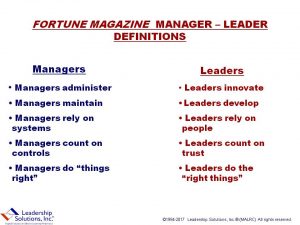by Peter A. Arthur-Smith, Leadership Solutions, Inc.®
“The leaders of history’s championship (sports) dynasties relied on a range of surprising traits; from dissent and rule-breaking to emotional self-control and low-key communication style.” Taken from WSJournal article by Sam Walker titled, ’The Seven Secrets of Great Team Captains,’ May 2017.
 |
Walker listed what he felt were the 16 greatest teams in international sports history covering 10 different countries, including the US. These teams he wrote, ‘…all had just one shared characteristic; Their long streaks of dominance began or ended…with the tenure of one player. And in every case, this player was, or eventually became the captain.’
He then went on to chronicle the seven qualities that he felt made them into the leaders they became, such as:
» Taking care of unglamorous tasks.
» Breaking the rules for a purpose.
» Practical communicator rather than giving lofty speeches.
» Using deeds to motivate people.
» Were independent thinkers; not afraid to ‘rebel.’
» Were restless individuals.
» Showed remarkable self-control.
Take a close look at this listing and compare it with the generally held view of leadership characteristics: like – charismatic, smooth-talker, toeing the party line, knows-everything, life-and-soul-of-the-party, brilliant speech maker, winner-in-every-way, power builder. Do you observe many differences?
Perhaps this is why we so often pick the wrong leaders and most certainly the wrong political ones, to the detriment of so many countries. It scares this writer, when he is considers how many bad political leaders there are in our world and thinking about how they possibly got there? Companies often pick the wrong leaders, sports franchises do the same, and so do school systems, universities, and so on. But those responsible for selecting these erroneous leaders still believe they know how to pick the right ones. This is not intentional, but due to a clear misunderstanding of what effective leadership is about. They know one, when they see one; is their refrain!
Now let’s draw upon an article from the New York Sunday Times, Business Section, May 2017 edition, entitled, “When Power Doesn’t Corrupt” by Matthew Hutson. It makes the point, ‘When you see power as a source of freedom, you are likely to use it yourself, selfishly. When you see it as a responsibility, you tend to be self-less.’ This emphasizes the point that, when executives are forced to consider issues important to their people, they are less power-hungry or selfish.
Unfortunately, too often, power-hungry executives accumulate sycophants around them – people who will say anything to make their lead-executives feel or look good. Such sycophants do their lead-executives and their organizations a disservice. They also expect the same from their own people or team leaders, hence such behavior cascades throughout their organization. Such organizations eventually become full of “yes-people” and then they begin to falter. Look at what happened to the great Roman dynasty; or other great dynasties come to that (Ottoman, Chinese or British Empires?).
Then there are the distinct differences between managers and leaders, even though we need both, as defined by a well known Fortune Magazine edition some years ago – you can see these nearby. Such definitions underscore manage-

|
ment as being more of a day-to-day control function and certainly is distinctly different from leadership. Leadership is more focused on tomorrow. There are very few executives who are strongly talented in both areas, so they have to either complement themselves or ensure they don’t take positions which won’t allow them to draw upon their management or leadership strengths… something hard to do for ambitious executives. It comes back to the selfishness again.
Leaders tend to be more objective about themselves and what they are and are not capable of. Managers tend to believe: the more they’re in-charge; the more they can control events…to our loss.
Beyond that, many executives have the know-how and capability to run a Savvy Enterprise, where they orchestrate:
» Vision-Strategy; » Communication; » Marketing, » Finance; and Technology.
However, this listing is only one side of running an effective enterprise. These competences alone cannot be duly optimized without organizations having a Resilient Backbone – by being capable in such areas as:
» Strong coherence; » Positive politics; » Robust morale; » Heightened productivity; » Healthy retention.
(NOTE: Authentic leaders are inherently better at these latter factors due to their natural bias toward people and progress; whereas managers are more inclined toward systems and process. Again, we need all four italicized dimensions in proper balance.) Let’s take a closer look at some of the differences in these five latter dimensions:
» Strong coherence – Managers primarily focus on numbers, which are only part of coherence. Leaders also take into account such things as – compelling purpose, across-the-team input, achievable objectives, inducing camaraderie, empowering people, and ensuring know-how availability. Accomplishing the latter five areas means work; whereas numbers can be happenstance and offer limited thinking required.
» Positive politics – Because they have been indoctrinated that way, managers too often focus on ‘what’s wrong’ and invoke negative politics – by getting people to compete against each other and constantly recording who’s up and who’s down. Leaders try to avoid these habits and encourage positive thinking and attitudes instead.
» Robust morale – Managers believe that by reaching their numbers and using financial incentives, they will induce a robust morale. As the father of modern motivational thinking, Fred Herzberg, or his modern counterpart Dan Pink in his book ‘Drive,’ will convince you: Money is a short-lived motivator. Herzberg relates: ‘Incentives are as short-lived as his mother needing to re-dust their house every day.’ Money doesn’t compare to treating people with respect, allowing them to succeed, being part of a warm-spirited team, endowing a feeling of trust, imbuing them with valuable knowledge, and offering a constant purpose.
» Heightened productivity – Managers apply all sorts of tricks to increase productivity: including automation, incentives, accountability, measurement, and so forth. In the right circumstances, extrinsic motivators like these can produce decent short-term results. Even so, as with all extrinsic motivators, the moment they are removed, productivity lags and so metaphorical whips have to be applied again and again, with an increasing price tag, until people grow tired of them or leave.
Leaders instead turn to human ingenuity, treating people with dignity, enabling them to monitor their progress, enthusing them through team camaraderie, allowing true empowerment, and instilling the right skill-set – all to inspire longer-term success that is self-sustaining.
» Healthy retention – Managers are inclined to use various gimmicks to minimize turnover. Their programs often unwittingly make workplaces more toxic rather than less; whereas leaders are realistic enough to accept that a certain amount of people-turnover is inevitable in a growing organization. Organizations can and should outgrow people. The lower leaves on trees and plants fall-off as they become bigger and stronger. It’s natural and acceptable within reason; as long as executives can look themselves in the mirror and feel they did everything reasonable to retain people.
So, from three different perspectives: Sport team leadership, Manager-leader differences, and Manager-leader options for building a ‘resilient backbone’: we understand more clearly ‘what leadership is and isn’t.’ With this extra clarity, you will be in a better position to make key decisions vital to leading your enterprise forward. Drop the myths and embrace the realities and you will succeed more than others in a leadership role.
To learn more about being a leader, talk with:
